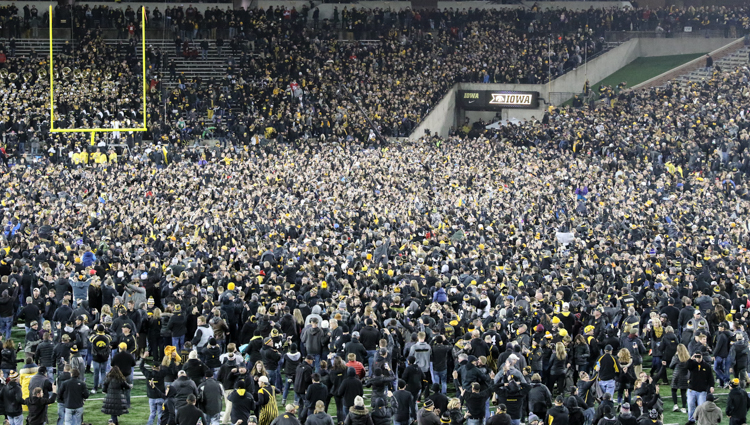Kinnick Stadium is easy to take for granted until you speak with an opposing player
By Pat Harty
CHICAGO – With all due respect to standout players such as tight end Noah Fant and quarterback Nate Stanley, the real star for the Iowa football team might not even be a player.
I was reminded of that on Monday at Big Ten media day as multiple players from opposing teams raved about the game-day atmosphere at Kinnick Stadium.
“I think Iowa is probably the hardest stadium I’ve played in personally just because the fans are literally yelling right on top of you,” Penn State defensive back Nick Scott said of Kinnick Stadium.
Penn State quarterback Trace McSorley echoed those sentiments on Monday, as did Michigan running back Karon Higdon, who was previously committed to Iowa before switching to the Wolverines.
Former Wisconsin running back Melvin Gordon also singled out Kinnick Stadium as being the toughest road environment in which he played in college. Gordon said the fans are a major distraction because they’re right on top of you due to how the stadium is designed and because they’re very knowledgeable.
“It’s just crazy in there,” Gordon said at the 2014 Big Ten media day event. “The fans are so close to the visiting bench to where they almost smother you. And they never let up.”
The fact that so many opposing players feel the same about Kinnick Stadium is very telling.
Iowa’s home field since 1929 is easy to take for granted until you hear opponents praise it for being such a hostile road environment.
Kinnick Stadium is dwarfed in size by some other stadiums in the Big Ten, but it compensates by having the fans so close to the playing field.
The Iowa players feed off that closeness, while opponents try to avoid having it become a major distraction.
"Just how close it is, and it's in the ground, so the sound stays in," said former Iowa All-America quarterback Chuck Long. 'I think it's intimidating for teams because the sideline is so close to them and they get all those fans behind them just razzing them the whole time in a good way. "The Iowa fans have always been good and gracious, but man, it can be intimidating for an 18-year old kid going into that stadium."
The seating capacity at Kinnick Stadium will dip slightly below 70,000 due to the renovation of the north end zone.
But the game-day atmosphere should be enhanced by the renovation.
“One of the reasons it’s one of the toughest places to play is because our fans are so passionate, so loyal and so loud,” said Iowa Athletic Director Gary Barta. “But they’re also right on top of the field.
“And if you’ve been out to the north end zone, we took the shift and went from about this to this, so it’s just closer and it’s higher. So yeah, I think it’s going to add to an already historic experience.”
The playing surface at Kinnick Stadium in 2017 featured an Iowa logo for the first time since the conclusion of the 1980 season.
A tiger hawk logo also was recently painted on the water tower that is located across the street from Kinnick Stadium.
And while all those little features help to improve the atmosphere and the ambiance at Kinnick Stadium, the design of the stadium is what makes it special.
Kinnick Stadium is everything that Carver-Hawkeye Arena isn’t with regard to the fan experience.
Iowa’s home court for basketball doesn’t have the same atmosphere, mostly because of how Carver-Hawkeye Arena was designed. The seats aren’t as close to courtside as the seats are to the playing field at Kinnick Stadium, so it’s more difficult to create a hostile environment.
Of course, winning is the biggest factor in creating an electric home atmosphere. But winning sometimes can be elusive and beyond reach.
That’s why it helps to have a setup like the one at Kinnick Stadium where the fans truly give Iowa a home-field advantage due to being so close to the field.
Just ask an opposing player.



